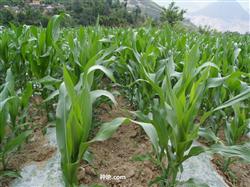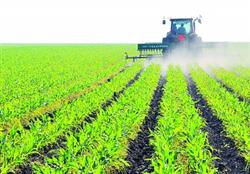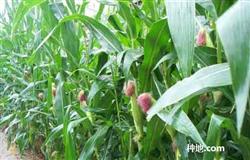How to grow corn scientifically?

How to grow corn scientifically? Please introduce that corn contains a large amount of lecithin, linoleic acid, glutamol, vitamin E, long-term consumption can effectively reduce serum and cholesterol, reduce the incidence of hypertension and arteriosclerosis, and delay cell aging and brain function degradation. There is an anticancer factor in corn-glutathione, which can "attack" cancer substances with its own chemical function, make it lose its toxicity, and then expel carcinogens from the digestive tract. Corn contains selenium and magnesium. Selenium can accelerate the decomposition of peroxides in the body, so that malignant tumors can not get the supply of oxygen, thus being inhibited, while magnesium can not only inhibit the development of cancer cells, but also make the waste in the body excreted out of the body as soon as possible. thus play an obvious role in cancer prevention. Corn contains lysine, which can not only inhibit the side effects of anticancer substances on the human body, but also inhibit tumor growth. Corn contains a lot of cellulose, which can accelerate intestinal peristalsis and shorten the residence time of food residue in the intestinal tract, so it plays an important role in the prevention and treatment of rectal cancer. Corn is rich in vitamins, such as carrots (provitamin A), B vitamins, vitamin E and so on. Carotene is transformed into vitamin An after entering the human body, which can prevent and inhibit the proliferation of cancer cells and restore the function of normal tissue. It plays a certain role in preventing lung, stomach, bowel and skin cancer. The synergistic action of vitamin A, E and group B can prevent cancer by invalidating carcinogenic chemical oxidants in vivo. The use of sweet corn sweet corn fresh ear: after harvest, it is directly sold to consumers through supermarkets or farmers' markets for household consumption, which is the simplest, the best taste quality, and the largest consumption. General sweet, enhanced sweet and super sweet can be used. Canned sweet corn: sweet corn kernel processing products, there are two kinds of whole grain and paste. Can be ready to eat, can also be re-cooking processing for family and catering industry consumption. In general, there are more super-sweet varieties. Sweet corn kernel: mainly provide processing raw materials for large-scale catering industry and food processing industry. According to the raw material requirements, several types of sweet corn can be used. Sweet corn ear: mostly used in the catering industry, such as sweet corn section in KFC fast food restaurants. General use of Pu Tian and some enhanced sweet varieties, super sweet varieties are more difficult to process. Vacuum preservation of fruit ears: the fresh-keeping period is 18 months, and the fresh-keeping effect is better, mainly for families and ready-to-eat consumption. There is a lot of room for development. Several types of sweet corn can be used. Vacuum fresh corn cob: basically the same as canned sweet corn, with a shelf life of 18 months. Because the cost is much lower than that of cans, it is expected to replace part of the canned market and enter the family, catering industry and food processing industry, with a wide range of market development space. Sweet corn beverage: the processing technology is simple, the cost is low, the appearance is beautiful, the taste is beautiful, nutrition and health care, is a product with huge potential market. Field weeding: herbicide, artificial weeding and seedling raising: soil mass seedling, seedling plate seedling, seedling bed seedling, direct seeding field fertilizer and water management: seedling stage, trumpet stage, heading stage, early pollination stage, filling stage field pest control: disease control, Experience of Pest Control and Green Fruit harvesting and planting techniques Exchange of Weed Control in Corn Field herbicides (such as glyphosate) are applied 5-7 days in advance. Gram without trace (effect on leaves) + Jindur, Acetochlor, etc.), the field should be kept moist when using herbicides. Then raise seedlings and sow seeds. During the planting period, plastic film mulching and artificial weeding can be used during the planting period. Sweet corn seedling 1. Pre-seedling preparation work to mobilize farmers: complete the seedbed, prepare bamboo, film, sunshade net and so on before the whole bed, you can sprinkle some lime in the field to adjust the pH of the soil. Sprinkle 2000 jin of farm manure or pig urine water, biogas water and so on. 2. Seedling raising methods: soil mass seedling, seedling plate seedling, seedling bed seedling, direct seeding 2-1, soil mass seedling, wet seedling bed with water, and 2-3 jin compound fertilizer / mu, 2-3 insecticidal granules (such as carbofuran, insecticidal, etc.) can also be sprinkled on the seedbed after sowing, but the amount should be less. To make a soil ball, take the fine soil from the field and mix it with water until the humidity is 60% Mo 70%, knead it into an egg-sized soil mass, put it on a pre-leveled seedling bed, and arrange it closely. After the picture group is slightly dry, gently press a shallow hole with the index finger, the general hole depth is about 1cm-1.5cm, the hole diameter is about 1.5cm, about 300pieces are made (to avoid excessive evaporation of water in summer), and then one seed is placed in each hole. Then cover 1cm thick semi-dry and wet fine soil, and use fine soil to fill the mud mass gap, if the soil is too dry, you can use a spray can to wet. Arch with bamboo, cover the film or sunshade net (available in sunny weather) or wet straw (used in dry weather), ventilate on all sides in summer and autumn, and keep the seedbed humid. When it grows into the first leaf, the film is removed without rain. 2-2. Seedling plate nursery to promote sprouting: mix the seeds with fine sand with a humidity of about 50% and 60%, pile them into a pile, and keep the temperature at about 30 ℃ until the seeds are broken, and the seeds are screened out for sowing. Sowing: put the seedling plate on the flat seedling bed, screen the soil in the seedling plate (half seedling plate), and sprinkle the rooting and seedling strengthening agent once, with 40g per jin of seeds. Put the seeds in the hole plate, wet the fine soil, arch it with bamboo, cover the film or sunshade net (available in sunny weather) or wet straw and wet plastic bags (used in dry weather), ventilate all around in summer and autumn, and maintain the humidity of the seedling bed. 2-3, seedling bed seedling leveling loose seedling bed, put the seeds evenly on the seedling bed, cover 1 cm thick fine soil and then wet to maintain the humidity of the seedling bed. Arch with bamboo, cover the film or sunshade net (available in sunny weather) or wet straw, wet plastic bag (used in dry weather), ventilation on all sides in summer and autumn, and maintain the humidity of the seedbed. 2-4, direct seeding: sowing, the distance between plants is controlled at about 30 cm, and the depth of the hole is about 1 cm. One seed per hole, the sandy soil is covered with the seed and compacted, and the thickness of the covering soil is controlled at about 1 cm. The lower temperature can cover the plastic film, and the plastic film can increase the soil temperature by 3-10 degrees. Spraying herbicides on the same day after sowing can ensure the weeding effect. Seedling stage management seedling bed management: maintain four sides ventilation, seedling bed humidity, one leaf begins to carry on the proper seedling refining. Seedling stage management after transplanting: 1. Seedling transplanting: seedlings are transplanted in time when the two leaves are in one heart (the bigger the seedling is, the more serious the root injury is), and the root water is poured, some insecticides for controlling ground insects can be sprinkled properly. 2. Promoting root and strong seedling at seedling stage: the growth period of super sweet corn is relatively short, so the early plant growth has a great influence on the final yield. So the supply of fertilizer and water must be fast in the first month! The smaller seedlings in the field can be irrigated several times to ensure that the seedlings are neat and convenient for management. Fertilizer and water management in the field after transplanting, each time is usually 5-6 days apart, depending on the specific growth and the amount of fertilizer used. 1, the first fertilizer: 10 jin / mu 15-15-15 Norwegian compound fertilizer on the day of transplanting, 2, the second fertilizer: after 5-6 days, 20 jin / mu 15-15-15 Norwegian compound fertilizer, the first two leaching fertilizers are all Norwegian fertilizer added to the fertilizer water to control underground insects. Drench directly on the root. After the second fertilizer, dig a pit with a diameter of 20 centimeters and a depth of about 5 centimeters between every four plants. The third fertilizer: 40 jin / mu compound fertilizer (10 Norway + 30 yuan blue fertilizer) the fourth and fifth times: 50-60 / mu (20 Norway + 40 yuan blue fertilizer) field pest control 1, pest control: 1-1, seedling stage is mainly underground pest control: sprinkle 2-3 granules to kill ground insects (such as carbofuran, dipterex, trichlorfon, etc.), it can also be sprinkled on the seedling bed after sowing. But the quantity should be less. 1-2. Aphids: imidacloprid, methotrexate, dimethoate and other agents. 1-3. The damage range of corn borer is wide, and there are many damage parts: leaves, stems, male ears and fruit ears, the damage period is long: from the middle of heart leaf to ear harvest, the damage degree is serious: fresh ear production, mechanized flow operation, the loss of one insect at the top is 1: 3; several insects and whole ears in the middle are scrapped. Therefore, the corn borer must be put in the trumpet mouth in the evening with 1 packet of BT powder (Bacillus thuringiensis) and 2 packets of Shongdan mixed with 5-6 jin of fine sandy soil (mixed half a day in advance). It can also be mixed with BT powder and insecticidal sheet, then placed in a mineral water bottle with a small hole and sprayed on the trumpet mouth or corn shreds by extrusion. Field disease control 1. One of the most common maize diseases can be controlled by triazole fungicides such as propiconazole and propofol. Generally in the five-leaf period, continuous rainy days before and after the prevention of the disease, often from the bottom of the leaves to start the disease. 2. striped leaf spots occur in the male stage, and can not be treated when the disease develops to the dry stripes, so prevention should be given priority to. At present, we understand propiconazole and propofol prophylaxis. Different from the symptoms of magnesium deficiency: there are residual bacteria on the leaves, which will spread the infection. 3. The black spike is mainly because the seeds carry bacteria when sowing, and the seed coating belt is wrapped with fungicides to prevent the infection, so the seeds are not soaked and the seeds are not cleaned. 4. Sheath blight: the disease harms the leaf sheath and stem of maize near the ground, causes stem base corruption, destroys transport tissue, and affects the transport of water and nutrients, which mainly occurs in the later stage of maize growth. Prevention and control agents: at the initial stage of the disease, 1% Jinggangmycin 400x + Tianda 2116 grain special type 600x were sprayed, or 70% methyl topiramate 700x + Tianda 2116 grain special type 600x were used for spray control. Control of corn rust by diseases and insect pests in the field: it mainly infects leaves and, in serious cases, can also infect ears, bracts and even male flowers. In the early stage, only light yellow long shape to ovate brown small purulent scar was scattered on both sides of the leaf, and the posterior vesicles ruptured and scattered ferruginous powdery matter, that is, summer spores of the pathogen; in the later stage, black near-round or oblong protuberances appeared on the disease spots, and black-brown winter hugs were exposed after cracking. Control methods (1) to avoid excessive application of nitrogen fertilizer and improve the disease resistance of the host. (2) at the initial stage of the disease, 25% triadimefon wettable powder 1500Mel 2000 times or 40% polysulfide suspension 600x liquid, 50% sulfur suspension 300x liquid, 30% solid stone sulfur mixture 150x liquid, 25% enemy demulsifiable oil 3000 times, 12.5% Suopoli wettable powder 4000 times, once every 7 days, prevention and treatment were carried out for 3 times in a row. Note: this cultivation technique is only summarized by our company based on many years of planting experience. It is impossible to fully suit the conditions of your area, so you should never copy it. According to the technical regulations of your local soil, climate and cultivation conditions, you need to constantly improve in the actual planting. Click to get more corn planting techniques click to get more food crop planting techniques
- Prev

How to fertilize corn correctly?
How to fertilize corn correctly? Please guide the following corn topdressing techniques for your reference: a fertilization of 3, 4 pieces. It refers to the combination of inter-seedling, fixed seedling, transplanting one-time fertilization, which is a basis to ensure that the seedling is complete and complete, and to promote seedling health. Generally, it is appropriate to use human manure and biogas fertilizer per mu.
- Next

What should be paid attention to in the ear stage of corn?
What should be paid attention to in the ear stage of corn? Please introduce that the ear stage of corn refers to the period from jointing stage to male ear flowering stage. Summer interplanting corn or summer direct seeding corn usually takes 25 Mel and 30 days. The vegetative growth and reproductive growth of maize at the ear stage are carried out at the same time, which is the most exuberant period. Corn is fond of temperature and required for growth and development at ear stage.
Related
- The first cup of black tea in spring, the flavor and history of tea gardens in Kenya, Africa
- The computer can not only choose potatoes, but also grow tea rice. AI will grow winter oolong tea champion.
- It is not only the inflated tea bitten by insects, but also engraved with the four seasons tea in Beipu.
- The Oriental Beauty Tea Festival in Zhuxian County takes the stage at the weekend to experience the plus-size feast of oil tea.
- & quot; Oriental Beauty Tea & Exploration of Emei in Hsinchu, the hometown of quot;
- The new variety of strawberry "Tainong 1" dessert is the first choice with mellow aroma. Crimson gorgeous
- History of Tea in Taiwan: from Wild Inner Mountain to Export Tea Garden
- Two types of Taiwan Oriental Beauty Black Tea won the British three-Star Award for Childhood Tea Xiang Zhang Jiaqi changed from pilot to champion tea maker.
- Banana species and varieties: the planting history of Taiwan Xianren banana and dwarf banana is long, is banana disease resistant?
- Coffee planting Technology: Qianjie Coffee from Seedling to harvesting

